BIOL201 (BIOL201)
American Public University
Page 3 out of 121 results
Sort by
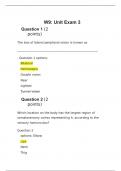
-
BIOL201 Week 9 Unit Exam 3 (Solved)
- Exam (elaborations) • 27 pages • 2023
-
- $46.12
- + learn more
1. Question: The loss of lateral peripheral vision is known as . 2. Question: Which location on the body has the largest region of somato sensory cortex representing it, according to the sensory homunculus? 3. Question: Axons in which tract are considered to be both ipsilateral and contralateral? 4. Question: Which region of gray matter in the spinal cord contains motor neurons that innervate skeletal muscles? 5. Question: Which region of the frontal lobe is responsible for initiating moveme...
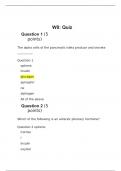
-
BIOL201 Week 8 Quiz 6 (Solved)
- Exam (elaborations) • 17 pages • 2023
-
- $24.03
- + learn more
1. Question: The alpha cells of the pancreatic is lets produce and secrete . 2. Question: Which of the following is an anterior pituitary hormone? 3. Question: The two major organ systems that participate in relatively "long distance" communication in order to control and coordinate actions in the body are the system and the system. 4. Question: Which general type of hormone can easily pass through the cell membrane and into the cytoplasm of the cell? 5. Question: The adrenal gland consis...
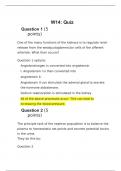
-
BIOL201 Week 14 Quiz 10 (Solved)
- Exam (elaborations) • 16 pages • 2023
-
- $24.03
- + learn more
1. Question: One of the many functions of the kidneys is to regulate renin release from the weak juxta glomerular cells of the afferent arteriole. What then occurs? 2. Question: The principle task of the nephron population is to balance the plasma to homeostatic set points and excrete potential toxins in the urine. 3. Question: Renin is released in response to . 4. Question: Mechanisms by which substances move across membranes for the absorption or secretion include . 5. Question: The primar...
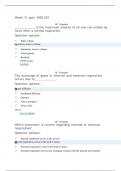
-
BIOL201 Week 11 Quiz 8 (Solved)
- Exam (elaborations) • 5 pages • 2023
-
- $13.63
- + learn more
1. ____________is the maximum amount of air one can exhale by force after a normal expiration. 2. The exchange of gases in internal and external respiration occurs due to _. 3. Which statement is correct regarding internal or external respiration? 4. The blood traveling to the lungs is generally described to be which of the following? 5. Which of the following are ways CO2 is transported in the blood? 6. The oro pharynx is a passage way for which of the following? 7. Which cell is responsi...
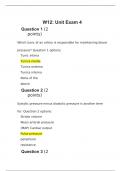
-
BIOL201 Week 12 Unit Exam 4 (Solved)
- Exam (elaborations) • 26 pages • 2023
-
- $46.12
- + learn more
1. Question: Which tunic of an artery is responsible for maintaining blood pressure? 2. Question: Systolic pressure minus diastolic pressure is another term for: 3. Question: These control the blood flow through a capillary bed. 4. Question: What is the sequence of layers of the blood vessels (veins or arteries) from outside to the inside? 5. Question: During vigorous exercise, one would expect: 6. Question: Venous return is affected by all EXCEPT: 7. Question: The amount of blood pumped b...
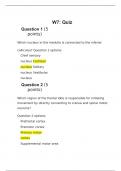
-
BIOL201 Week 7 Quiz 5 (Solved)
- Exam (elaborations) • 15 pages • 2023
-
- $24.03
- + learn more
1. Question: Which nucleus in the medulla is connected to the inferior colliculus? 2. Question: Which region of the front allobe is responsible for initiating movement by directly connecting to cranial and spinal motor neurons? 3. Question: The thalamus is the transfer point for most sensory tracts to reach the cerebral cortex. An exception would be which of these? 4. Question: The loss of lateral peripheral vision is known as . 5. Question: Which location on the body has the largest region ...
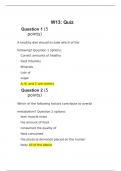
-
BIOL201 Week 13 Quiz 9 (Solved)
- Exam (elaborations) • 13 pages • 2023
-
- $24.03
- + learn more
1. Question: A healthy diet should include which of the following? 2. Question: Which of the following factors contribute to overall metabolism? 3. Question: The carbohydrates, lipids, and proteins in the foods you eat are used for . 4. Question: Fever increases the body temperature and can induce chills to help cool the temperature back down. What other mechanisms are in place to regulate the body temperature? 5. Question: Starvation sets in after 3 to 4days without food. Which hormones cha...
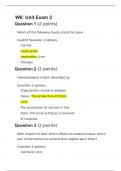
-
BIOL201 Week 6 Unit Exam 2 (Solved)
- Exam (elaborations) • 35 pages • 2023
-
- $50.02
- + learn more
1. Question: Which of the following foods is best for bone health? 2. Question: Hematopoiesis is best described as: 3. Question: With respect to their direct effects on osseous tissue, which pair of hormones has actions that oppose each other? 4. Question: Wolff's law, which describes the effect of mechanical forces in bone modeling/remodeling, would predict that . 5. Question: Bone growth in diameter is known as: 6. Question: How many vertebrae are located in the thoracic region? 7. Ques...
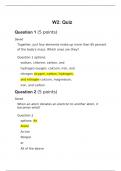
-
BIOL201 Week 2 Quiz 2 (Solved)
- Exam (elaborations) • 16 pages • 2023
-
- $24.03
- + learn more
1. Question: Together, just four elements makeup more than 95percent of the body’s mass. Which ones are they? 2. Question: When an atom donates an electron to another atom, it becomes what? 3. Question: What are organic compounds, such as carbohydrates, lipids, proteins, and nucleic acids, within the human body often referred to as? 4. Question: The characteristic that gives an element its distinctive properties is its number of what? 5. Question: Which of the following is NOT a part of th...
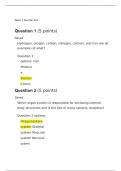
-
BIOL201 Week 1 Quiz 1 (Solved)
- Exam (elaborations) • 16 pages • 2023
-
- $24.03
- + learn more
1. Question: Hydrogen, oxygen, carbon, nitrogen, calcium, and iron are all examples of what? 2. Question: Which organ system is responsible for enclosing internal body structures and is the site of many sensory receptors? 3. Question: Which organ system is responsible for secreting hormones and regulating bodily processes? 4. Question: What is the metabolic process whereby smaller, simpler molecules are combined in to larger, more complex substances? 5. Question: Which organ system is respon...

Do you wonder why so many students wear nice clothes, have money to spare and enjoy tons of free time? Well, they sell on Stuvia! Imagine your study notes being downloaded a dozen times for $15 each. Every. Single. Day. Discover all about earning on Stuvia


